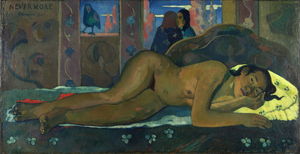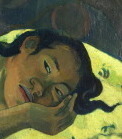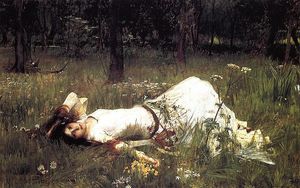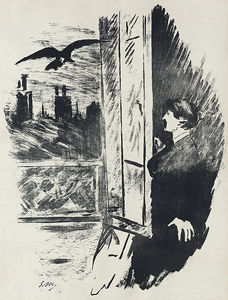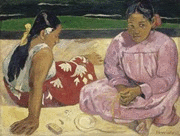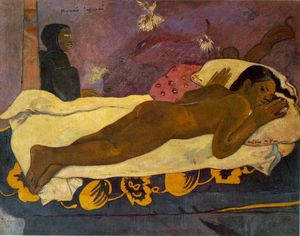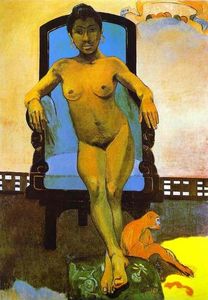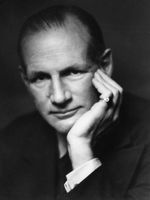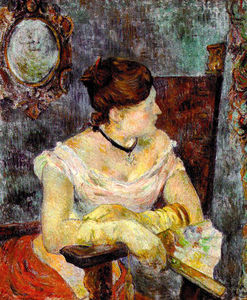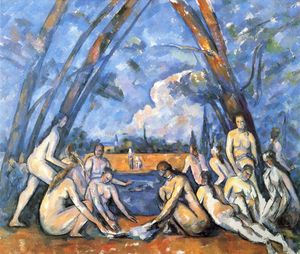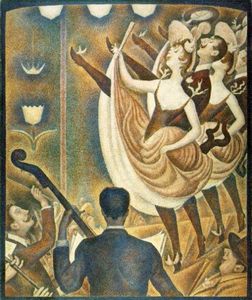Nevermore
- Date of Creation:
- 1897
- Height (cm):
- 60.50
- Length (cm):
- 116.00
- Medium:
- Oil
- Support:
- Canvas
- Subject:
- Fantasy
- Framed:
- No
- Art Movement:
- Post-Impressionism
- Created by:
- Current Location:
- London, United Kingdom
- Displayed at:
- Courtauld Institute of Art
Nevermore Story / Theme
Edgar Allen Poe, The Raven:
"And the raven, never flitting, still is sitting, still is sitting
On the pallid bust of Pallas just above my chamber door;
And his eyes have all the seeming of a demon's that is dreaming,
And the lamp-light o'er him streaming throws his shadow on the floor;
And my soul from out that shadow that lies floating on the floor
Shall be lifted - nevermore!"-

Nevermore
-

Nevermore
Edgar Allan Poe's famous 1845 poem The Raven was a key source for the story of Gauguin's Nevermore, and as such is referenced in the title. In the poem itself, according to art historian Dario Gamboni, the continual use of the refrain "nevermore" is an expression of sadness meant to produce poetical beauty. Similar to Gauguin as an artist, Poe's works are centered on subjects of beauty, melancholy, past lovers, longing, and efforts to communicate with the dead.
Gauguin could be commemorating the actual physical death of a lover, or referencing the symbolic death of an affair. Gauguin may also be simply paying homage to Poe (though correspondence would suggest against that) or lamenting the ephemeral nature of love, erotic pleasure and beauty. With Nevermore, the encounter with the erotic and the exotic creates an entirely new context for Poe's grievous reflection on lost love.
At the time he created this work Gauguin was very stressed. In 1895 he left Europe for Tahiti for the final time. Upon his arrival he did not find any internal peace but poor health (the effects of syphilis), which stripped him of his savings. In April 1897 he learnt of the death of his daughter Aline, to whom he was deeply attached. She was only 20 and died from pneumonia on the way home from a ball. This period of despair corresponded with a prodigious creative output, for during this time he painted, sculpted and wrote a great deal, including Nevermore. Could the raven been signaling the death of his daughter Aline?
Gauguin's intent with Nevermore is to lead the viewer away from the world of reality. Gauguin was looking to coax the viewer into giving way to the artwork's sensuality in the same way one does listening to music. He wanted to portray the Tahiti and women as he saw them, not necessarily a photo-like representation, but as possessing something mysterious and penetrating.
Nevermore reflects Gauguin's constant search for answers to his spiritual needs, and represents Gauguin's reasons for being an artist. This work holds up a mirror to the all important chapter of his life in Tahiti.
Nevermore Inspirations for the Work
European painters of the 19th century often looked to literature for subject matter and creative inspiration. Just as William Shakespeare's tragic character Ophelia informed British artist J. W. Waterhouse, the sad poetry of American writer Edgar Allan Poe influenced Gauguin's iconic painting Nevermore.
It is the title of Nevermore and the picture of the bird that bring to mind the poem The Raven by Edgar Allen Poe. The poet had a cult following in Parisian artistic circles and in 1875 Manet had illustrated Mallarme's translation of the poem. In it, the author's imagination is haunted by a menacing raven, who utters only one sound, Nevermore. Gauguin was aware of this and factored it into his painting, although he later sought to play down the connection.
The mystery behind the piece is also part of its genius. One is left wondering what the inspiration was. What tragic event did Gauguin foretell at this time? What prophetic news was the raven bringing?
Nevermore Analysis
Excerpt from Paul Gauguin's personal correspondence:
"It is not at all the raven of Edgar Poe but the bird of the devil who watches. It is badly painted (I'm nervous and work in jerks), but all the same I believe that it is a good canvas. I wanted to suggest by a simple nude a certain barbarian luxury of past years. The whole thing is flooded in colors deliberately somber and sad; it isn't the silk, the velvet, the cambric or the gold that gives this impression of luxury but purely the material, that becomes rich under the hand of the artist ... the play of man's imagination alone has enriched this house."
-

Nevermore
-

Nevermore
-

Nevermore
-

Nevermore
Composition:
Gauguin's Nevermore was composed so as to simultaneously suggest and deny reality. As such, the painting's space is portrayed more through a combination of decorative panels than by the illusion of three-dimensional space. The figures and bird in the background may be real, yet at the same time they may be figures painted onto a screen. Whatever they are, they are not random, because Gauguin's ambiguity in this piece is intentional, and it fulfils his aim of filling the painting with mystery.
Because Nevermore is not an accurate transcription from life (Gauguin liked to paint from memory, plus his eyesight was failing him by this stage) the girl lies in an awkward pose with her right hip strangely distorted and elevated. Her right arm partially covers her breasts and her face is cupped in her left hand. Besides his physical ailments, Gauguin was not interested in painting the external reality of his subjects, rather focusing his priority on his own inner vision.
Color palette:
Nevermore is an example of Gauguin's habit of using color for purely emotional effect. The colors are intentionally anti-naturalistic because Gauguin wants the viewer's eye to meander along the curves of the subject's body and the attractive patterns in the background. Gauguin also effectively uses contrast to heighten visual awareness and sentiment for the subject. The straight verticals in the background are carefully placed to highlight the curved sensuality of the reclining nude. The all-important small accents of red intensify the greens and the blue and yellow act as complimentary contrast.
Use of light:
Gauguin's Nevermore has a sense of light which is created by a glowing emanation of color. Because of this, photos rarely do the artwork justice. The tones are actually rather dark, and the texture is mostly rough and dry. The romantic ideal is summed up in this painting by its color and sense of restless change within an overall order, shifting registers, and many possible points of focus backed up by a feeling of confident constant unity.
Mood, tone and emotion:
Gauguin's image is all the more provocative because the figure is a young woman who does not fit within Western definitions of beauty and sexual propriety. Gauguin's approach to art was not about tradition or reverting to Classical or Romantic styles. The female figure is beautiful, but decidedly exotic by 19th century European standards.
Brush stroke:
Gauguin's use of brush stroke is impressive and evokes feelings in both the viewer and subject. In combination with his use of color, Gauguin uses emphasis in brush stroke through various parts of the painting to draw the attention of the viewer.
Nevermore Critical Reception
Mathew Collings, 2010
"For me the word 'romantic' in a painting context means feeling. It has nothing to do with subject matter. The romantic ideal is summed up for me by this painting because of its sense of restless change within an overall order, shifting registers, and many possible points of focus backed up by a feeling of confident constant unity."
Dr. Ernst Vegelin, Head of The Courtauld Gallery
"I think people are drawn to this painting because it is so rich in its possibilities and it is not as straightforward as it might initially seem, with the raven and the figures in the background bringing a sense of mystery."
Gauguin's Nevermore was not critically received during his lifetime due to both the proximity to his death after completion (6 years), and the distance separating the center of the artistic world, Paris, from Tahiti in 1897. In spite of the self-enforced isolation that prevented Gauguin's critical appraisal after 1895, judging by the lackluster reaction his Tahitian work received upon his first return to France, there is no evidence that Nevermore would have been met with acclaim during his lifetime.
It was only after his death that Gauguin's total body of work, including Nevermore, enjoyed widespread critical approval. An enthusiasm for purchasing Gauguin's artworks came in posthumous exhibitions in the Salon D Automne in Paris in 1903 and 1906. The vogue for Gauguin's paintings had a great influence on the French Avant-garde movement.
An Art Fund poll carried out in 2010 asked, "Which of these people has captured your idea of romance in art?" and this resulted in Gauguin's Nevermore being selected out of five thought provoking artworks chosen by highly qualified art critics. British artist and writer Mathew Collings chose Gauguin's Nevermore.
Nevermore Related Paintings
Nevermore Locations Through Time - Notable Sales
Nevermore was first owned by French/English composer and friend of Gauguin, Frederick Delius. It was originally purchased for 500 francs in Paris. It was then bought by Samuel Courtauld, a rich businessman from a distinguished family in 1926. It resides permanently in the Courtauld Gallery.
There seems no clear reason as to why Courtauld, described as being aloof and autocratic, would purchase a Gauguin. There is also no evidence that gives an indication of what circumstances dictated its purchase. However, Courltauld's private verses and sonnets perhaps give some clue to his affinity with Nevermore.
"Beauty to me of course is spiritual as well as physical and the most complete Beauty must be both. I feel too that bodily beauty is closely and subtly linked with beauty of spirit. This feeling about Beauty and the need for it are essential parts of me: unless women have beauty they are antipathetic to me in life as well as art. It is an ingrained prejudice... "
Could Nevermore have been on his mind when he wrote these words?
Nevermore Artist
Gauguin's Nevermore was painted during his second visit to Tahiti in 1897.
In Mario Vargas Llosa's Way to Paradise, a fictionalized account of Gauguin's life, he details a not implausible scenario to explain Gauguin's inspiration in creating the mysterious and foreboding Nevermore. In Vargas Llosa's version the girl (depicted in the painting) is pregnant with Gauguin's child and the raven in the background represents a coming calamity - the miscarriage that subsequently occurs. Indeed, Nevermore may be seen as an effort to exorcise his grief over the loss of his unborn child and as such his failure to ever really connect or become one with the people of Tahiti.
Nevermore Art Period
In an attempt to remove himself from Western conventions, Gauguin emigrated to the Tahiti in 1893 and made sculptures and woodcuts with a deliberately rough look. His more primitive work was interspersed with images more luxuriant and poetic as he developed his orchestrated tonal harmonies as seen in Nevermore. Gauguin's self exile to Tahiti needs to be seen as the most logical extreme of the art movements he inspired in the Pont-Aven school, Brittany, France.
These movements involved not only a search for new forms and new realities, but also a search for new content and new principles of synthesis. This became a conscious program in Gauguin's paintings.
It was in Tahiti where the mystery of a native (and therefore to him beautiful) people living in an earthly paradise haunted by the gods and spirits of their religion that Gauguin's interest was satiated. The subjects he pursued were those of the Romantic tradition - the exotic, the otherworldly and the mystical. In this, Gauguin was affected by the Symbolist spirit.
Gauguin painted Nevermore in the latter stages of his return trip to Tahiti. His eyes would have already begun to fail him, and the rest of his body was braving the effects of his advanced syphilis. He would have painted this work with complete knowledge that his artistic ability was coming to an end. This possibly explains the high quality of work he produced during this time.
Nevermore Bibliography
To learn more about the life and works of Paul Gauguin please refer to the following recommended works.
• Eisenman, Stephen F. Paul Gauguin: Artist of Myth and Dream. Skira Editore, 2008
• Gayford, Martin. The Yellow House: Van Gogh, Gauguin, and Nine Turbulent Weeks in Arles. Penguin, 2007
• Gauguin, Paul. Noa Noa: The Tahiti Journal of Paul Gauguin. Dover Publications Inc. , 1985
• Schiff, Richard, et al. Gauguin: The Origins of Symbolism. Philip Wilson Publishers Ltd, 2004
• Shackelford, George T. M. & Freches-Thory, Claire. Gauguin Tahiti: The Studio of the South Seas. Thames Hudson, 2004
• Thomson, Belinda. Gauguin: Maker of Myth. Tate Publishing, 2010

